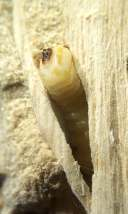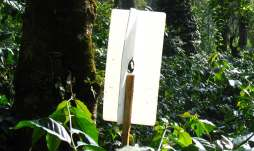Management of Coffee White Stem Borer
White stem borer, Xylotrechus quadripes is the most serious pest of arabica coffee in India. Arabica coffee is the most preferred and principal host plant. Other host plants include robusta coffee, tree coffee, teak, Olea sp., etc. However, its breeding in plants other than arabica coffee is very rare. The adults are slender, elongate (2-2.5cm in length) beetles with a pair of long antennae. The forewings are black with characteristic white bands. Males are generally smaller than females.

Beetles are active during bright and hot weather.
Female beetles lay eggs in the cracks and crevices of the bark and under the loose scaly bark of the main stem and thick primaries, preferring the plants exposed to sun light.


Each female lays about 100 eggs. Eggs are elongate, oval, milky white at first and turn pale yellow later.Eggs hatch in 9-15 days. Hatched out grubs bore into the corky portion of the bark and they feed on the periphery of the stem for about two months. Later they enter in to the hard wood and make tunnels in all the directions. In some cases the tunnels may extend into the roots. The tunnels are filled with excreta of the grubs.
The grub stage lasts about 10 months after which it pupates in a chamber close to the bark. The fully grown larva is about 2-3 cm long, pale yellow and broader at the head region. The pupal stage lasts for 3-4 weeks after which it transforms into an adult beetle. The adult remains in the tunnel for 3-7 days, and emerges out by cutting an exit hole.
Symptoms and damage
Affected plants show externally visible ridges around the stem. They may also exhibit signs like wilting and yellowing. Infested plants (up to 7-8 years old) die in a year, while older plants withstand the attack for a few seasons. However, such plants are less productive, yielding more floats.
They may also exhibit signs like wilting and yellowing. Infested plants (up to 7-8 years old) die in a year, while older plants withstand the attack for a few seasons. However, such plants are less productive, yielding more floats.
Flight periods
There are two peak emergences or flight periods; one during April-May and the other during OctoberDecember. Cloudy and wet weather delay the emergence of the beetles.
Management
a) Shade maintenance
Two tier system of shade is essential. The upper level of mixed species of permanent shade trees and a lower level of temporary shade trees like dadap, (Erythrina species) is required. The shade trees should be regulated in such a way that the coffee plant is not exposed during the flight period of the beetles.
b) Tracing stumping/uprooting and destruction
 Tracing can be done throughout the year relying on the ridges on the coffee plant as identification marks. The infested plants also show symptoms of yellowing and wilting during periods of moisture stress. The borer affected plants, during this period, show wilting symptoms, especially the drooping of the first pair of leaves on the branches. This generally happens after cessation of monsoon. Such plants need to be uprooted immediately and destroyed by burning. As the moisture stress increases, healthy plants also would show slight symptoms of wilting and the difference between healthy and borer infested plant would not be that obvious unless the infestation is severe. In the coffee tracts of Karnataka, severely affected plants are killed outright; but in the coffee tracts of Tamil Nadu like Yercaud and Pulneys where rainfall is received almost throughout the year, the infested plants survive for longer period, acting as reservoirs of beetle population.
Tracing can be done throughout the year relying on the ridges on the coffee plant as identification marks. The infested plants also show symptoms of yellowing and wilting during periods of moisture stress. The borer affected plants, during this period, show wilting symptoms, especially the drooping of the first pair of leaves on the branches. This generally happens after cessation of monsoon. Such plants need to be uprooted immediately and destroyed by burning. As the moisture stress increases, healthy plants also would show slight symptoms of wilting and the difference between healthy and borer infested plant would not be that obvious unless the infestation is severe. In the coffee tracts of Karnataka, severely affected plants are killed outright; but in the coffee tracts of Tamil Nadu like Yercaud and Pulneys where rainfall is received almost throughout the year, the infested plants survive for longer period, acting as reservoirs of beetle population.
It is strongly recommended that borer infested plants should be traced and removed before the beetles emerge out in order to prevent further egg laying.
Uprooting and destruction of borer infested plants should be completed during March and September every year.
Before uprooting the infested plants should be stumped. If the borer has entered into the root, the entire plant has to be uprooted and destroyed otherwise allow suckers for rejuvenation. Once the plants are uprooted, the gap should be filled up in the ensuing planting season and the healthy plants surrounding this open patch should be given special protection by timely scrubbing and lime application as described in the following sections. Further, temporary shade tree stakes should be planted in the gap which can be regulated later.
As the pest develops faster in cut stems, storing of uprooted stems on the estate should not be done. The uprooted stems have to be burnt immediately. If the stems have to be used for other purposes then they should be immersed under water for at least ten days so that all the stages inside are killed. The stems can be stored after this treatment.
c) Scrubbing
 Remove the loose scaly bark of the main stem and thick primaries using coir glove to reduce the cracks and crevices in which the eggs are deposited. Scrubbing should be completed before the flight period i.e. by March and September every year. Deep scrubbing with any sharp implement should be avoided as it may injure the green tissue leading to death of the plants.
Remove the loose scaly bark of the main stem and thick primaries using coir glove to reduce the cracks and crevices in which the eggs are deposited. Scrubbing should be completed before the flight period i.e. by March and September every year. Deep scrubbing with any sharp implement should be avoided as it may injure the green tissue leading to death of the plants.
d) Use of pheromone traps
The coffee white stem borer pheromone trap can be installed on coffee estates for monitoring and trapping the beetles during the peak flight periods (April-May and October-December) to reduce the infestation. The pheromone trap used for monitoring of the white stem borer adult activity is of the cross-vane type and consists of the following:
Two pre-glued panels of size 20 x 10 inches made out of white polypropylene sheet of 3mm thickness with a circular window of 2.5 inch diameter at the centre. The panels are coated with ploybutene glue. A longitudinal slit up to the centre is provided in each panel so that the panels can be slid over each other to form the cross. A small vial (with lure) with cap attached with a wire for hanging the same in the window.
The steps in installing the traps are illustrated
The cross vane is mounted on a wooden stake (a pole cut from a tree also can be used) of 5 feet length so that the overall height of the whole unit is about 6 to 6.5 feet. At the centre of the window is placed the lure or bait material contained in a small polyethylene vial of size 1 inch with a diameter of 0.5 cm. The lure is the synthesized male sex pheromone of the coffee white stem. The chemical name is 2-hydroxy-3-decanone, which is specific to this species.

The traps should be spaced out in the form of a grid of 25 traps each with a spacing of 20 m between traps.Installing of traps alone will not give the desired results.
All the other measures should be integrated to get the best results.
e) Chemical measures
Spraying 10% lime (spray lime at 20kg in 200 litres of water along with 200ml Fevicol DDL) on main stem and thick primaries is found to afford good protection against the borer attack.  But lime spray should be completed before the flight periods. The lime spray should be directed on to the main stem and primaries in such a way that the lime fills the cracks and crevices, preventing the female borer from laying eggs on such surfaces. It is best if the lime spray is taken up after a light scrubbing of the stem so that the loose scaly bark is removed and the lime adheres better.
But lime spray should be completed before the flight periods. The lime spray should be directed on to the main stem and primaries in such a way that the lime fills the cracks and crevices, preventing the female borer from laying eggs on such surfaces. It is best if the lime spray is taken up after a light scrubbing of the stem so that the loose scaly bark is removed and the lime adheres better.
Use of any insecticide should be exercised only in hot spot areas.  Spray the main stem and the thick primaries once during mid April and once during end October or first week of November. Since the winter flight period is of long duration, one more spray may be given in the first week of December with Chlorpyrifos 20 EC at the dosage of 600 ml in 200 litres of water along with 200 ml of any wetting agent. Chemical application should be completed before the peak emergence period of the beetle to achieve effective control.
Spray the main stem and the thick primaries once during mid April and once during end October or first week of November. Since the winter flight period is of long duration, one more spray may be given in the first week of December with Chlorpyrifos 20 EC at the dosage of 600 ml in 200 litres of water along with 200 ml of any wetting agent. Chemical application should be completed before the peak emergence period of the beetle to achieve effective control.
Source:
Central Coffee Research Institute
Coffee Research Station – 577 117
Chikmagalur District, Karnataka
